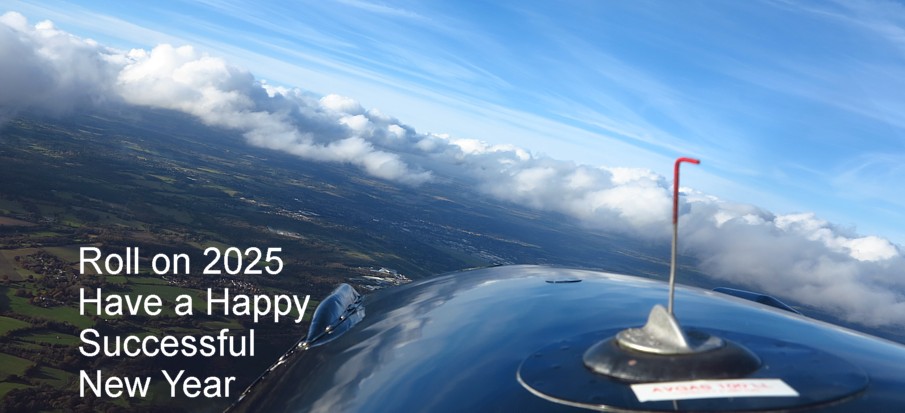
All the best for 2025

All the best for 2025
The new update page 2025. If you've already read this page it's time to move on.
2024
January
I woke up at 06:00
on the 1st of January, it was a pleasant 21º Centigrade in
Nonghoi, Chiang Mai. I lay in until 09:00 and then got up to make
my porridge laced with honey, two mugs of hot English tea, and I
had a Strawberry yoghurt.
This time 1st January 2025, it will be around 8° Centigrade, and
wind and rain is forecast here in Westleigh, Devon.
Many changes have occurred in my life during the past year, many are not so savoury, but let's focus on the fun flying I have had.
Chiang Mai is the
place I need to be to re-establish my emotional and psychological
health. It is a great place to meditate, and to see happier
people everyday, brings a level of contentment.
England is likewise a happier place, and very social, and I am
very fortunate to be here, but this time of the year I'd rather
be in Thailand.
For me, my first
flight of 2024 was with Ed in the Tecnam P92-JS.
Ed was one of my PPL students in 2007, and since then he has
moved on to a turbo prop powered Malibu JetProp. The Tecnam was
bought by him in 2007, and he finished his PPL in it. I told him
that he would probably keep it for a long time, and indeed he has
still got it.
From time to time I am still engaged to do a flight review and so
on the 25th January we went flying from Nok in order to check the
options for EFATOs around the field and to do some Practice
Forced Landings (PFLs) in the Tecnam.
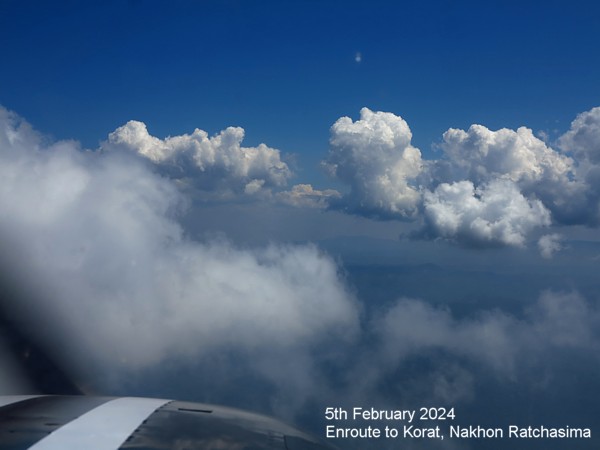
February
When Khun Mao
bought HS NOK, the Cessna F182R, I was engaged to check him out.
It's usual that people who have flown with me to want to fly with
me again, this is called reputation; so every time I travelled to
Thailand since then I have managed to get a flight in with him.
This is to our mutual benefit, I do like to fly, and I especially
like to use the instructional skills I have developed.
On the 5th
February we flew from Klong 11, which is NNE of Bangkok, to
Nakhon Rachasima where we practiced a couple of PFLs.
On our return to Klong 11 we did another practice forced approach
from the downwind to base turn.
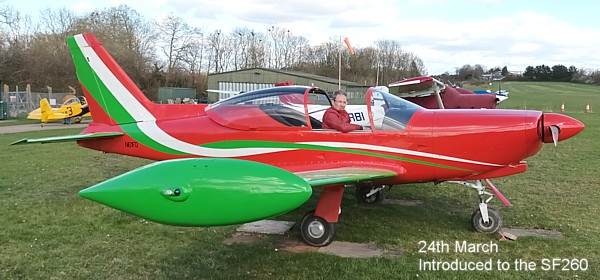
March
24th March. The flight in the SF260 was cut short when oil smeared the windscreen... Of course we landed again to check it out... Cowlings open and the clean engine checked; where? 'Turned out to be that the cowling piano hinges had been lubricated and the oil had streamed back. It does not take much oil to make a mess.
30th March was a
big day. Paul Kirkham had made a superb job of building a Sling
2, and I was engaged to do it's test flying.
This aeroplane is a bit different to the norm, it is the
tailwheel version, and it has been fitted with a UL Power engine
rather than the usual Rotax 912.
I took it up for thirty minutes above Popham Airfield, approached
the stalls without and with flaps, to establish minimum speeds,
and then returned to land.
The aeroplane flew well with one minor snag, a slight roll to the
left which was later solved with a small trim tab.
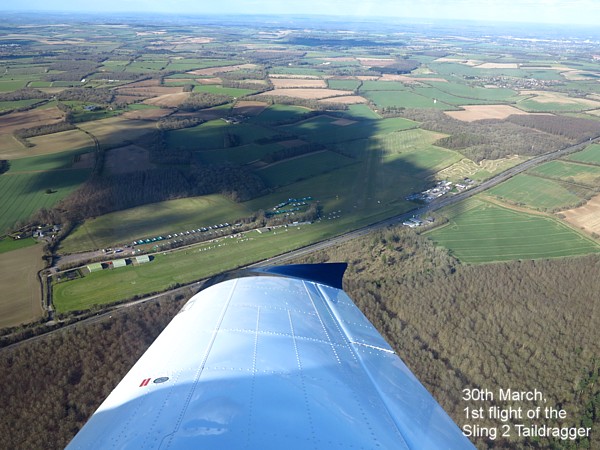
April
First flight in April was with Craig in his SF260 when we went up to do airwork (steep turns, stalls etc) followed by a couple of stop and goes.
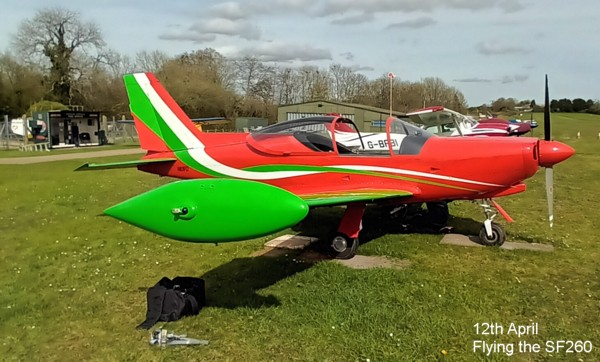
13th April I did three test
flights in the Sling 2: Solo, with Keith (aeronautical boffin) as
observer, and Iain Kirkham (son of Paul the builder, and soon to
be an engineering boffin) as observer.
Full stalls were done with Keith on board to record their
airspeeds and tendencies, and a full power level run was flown.
The aeroplane was well behaved throughout.
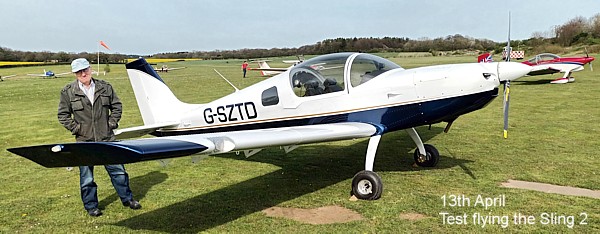
14th April was
Paul's first opportunity to fly in his aeroplane, but now the
snags began! There's always snags.
First the red light came on to indicate Low Voltages as we
climbed out... Land, sort it out and go again.
This time the Low Voltage light came on again, but the voltage
was holding steady... The number 2 EGT went wild, (later the
probe was swapped, and then a new one was purchased). The Low
Voltage was solve when cooling air was routed to the Voltage
Regulator on the firewall.
19th April it was
up in the SF260 to have a fly around, all happy until the misty
rain arrived to spoil our fun.
I was to demonstrate landing the SF260 on the scary runway 26 off
the slant final approach at Popham. The misty drizzle that
settled on the windscreen was no help, thank you very much, and
so I flared a little high and the trailing beam undercarriage had
to do it's job and not make Michael look bad.
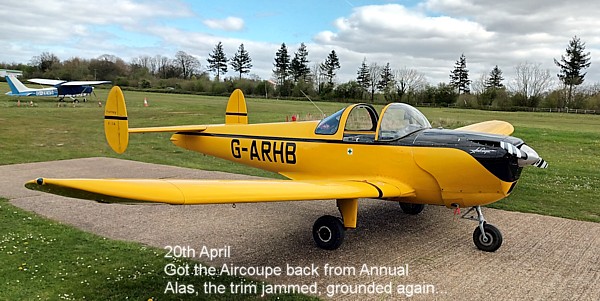
20th April began
with another flight in the SF260 with Craig, stalls, and three
stop and go landings.
I did a quick flight in the Aircoupe which had just come off its
Annual Check. It's very important to do a test flight after a lot
of maintenance.
Paul had repitched the propeller, adding another half degree, and so we went up to test the Sling 2.
21st April,
another test flight in the Sling 2.
30th April, another propeller pitch adjustment, and another test
flight in the Sling 2, the air was bumpy and the DUC prop a
little too coarse.
Repitched a little finer afterwards.
May
4th May I flew with Paul in the Sling 2 as we set up the autopilot. Paul did a good takeoff and a good landing, and so he logged Pilot In Command.
7th May I renewed my UK Class 2 pilot medical, £360, (apparently there will be an additional requirement of a stress ECG next year +£500 or so).
12th May, Thruxton
offers free circuits for one landing fee, and so we took the
Sling 2 there to do three grass and one hard runway landings.
The hard runway is a way to check ability to keep straight.
Unfortunately this showed up the problem with the rudder pedals;
the ease with which inadvertent brake may be applied by larger
shoe sizes.
Paul was PIC again for the return to Popham.
17th May, David
Crouchman was observer as we took the Sling 2 up to calibrate the
Angle Of Attack display system. This is useful when approaching
the stall, and for optimum landings.
18th May, David and I flew twice, first to do four things, the
Rate of Climb test, the scary dive to Vne (Velocity Never
Exceed), the Airspeed Calibration (fly triangles), and the two
hour endurance. Later, when the weather cleared again, we did the
Radio and Transponder test with Farnborough at a distance.
23rd May, I had a ride with John in the Tiger Moth from White Waltham to Popham and back.
24th May, flew with Iain in the Sling 2 to do further testing of the autopilot.
30th May, had a passenger flight with WestJet to Calgary, and then to Vancouver.
31st May, pulled the Chipmunk out of the hangar and went for a solo flight over the Golden Ears, Widgeon Lake, a few barrels on the way around and back to Langley, British Columbia. 'Seems that this would be my last flight in the Chipmunk... It has been a fantastic 22 years.
Marilyne had kindly supplied me with a buddy pass to enable me to fly to Vancouver on WestJet (30th May), and Emidio was kind enough to give me accommodation next to Nanaimo Skytrain Station..
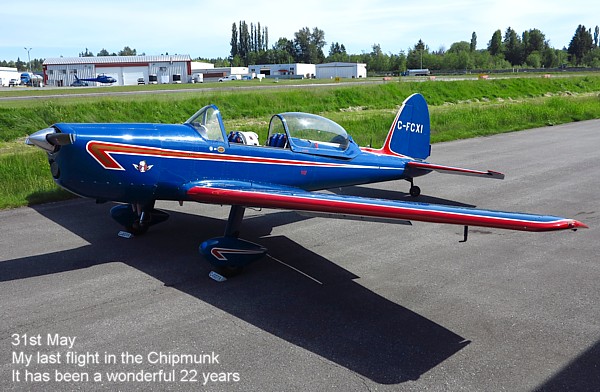
June
6th June, I flew
with Archie in the Piper Tomahawk from Boundary Bay. This was a
partial check flight with steep turns and stalls over Pitt Lake,
and two circuits.
I did not log this flight as my Canadian Class 1 medical had
expired and so I could not use my Instructor Rating or my CPL.
That afternoon I did renew my Class 1 medical at a cost of
$373.80c CAD including another ECG.
7th June, now I can log a dual flight to check Archie out with a flight from Boundary Bay to Abbotsford, seven circuits, and back to Boundary Bay.
10th June, I'm
busy in the Piper Tomahawk again. This time to do some flying
with David M who was renewing his Class 2 Instructor Rating after
many years.
As a Chief Flying Instructor it has been my job to ensure
instructors are up to my standard, and so I have helped many to
improve their instructional techniques. Strictly speaking this is
Class 1 instructor's work, I'm a Class 2, but it's the Peare
tradition to be underqualified for the work we actually do!
The second flight was a repeat with Archie to do 6 circuits at Abbotsford followed by a surprise PFL in the Cloverdale area.
12th June, More
instructional coaching with David in the Tomahawk, stalls, slow
flight.
I've decided to never again use the Fraser Bridge route, building
work in New Westminster renders this illegal with the 1,200 foot
airspace restriction.
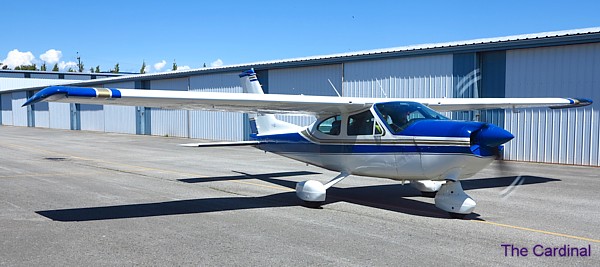
15th June, Howard Gold was
visiting from England and looking for some seaplane
opportunities. He flies a Cirrus normally.
Seaplane aside, I suggested some tailwheel training, and so we
went flying together in the Citabria out of Squamish. It was a
gusty windy challenging day to fly.
17th June, Roel asked me to
do some recurrency flying with him in his Pelican PL aeroplane
from Squamish. Steep turns, stalls and PFLs.
Then it was up with Howard to do some circuits followed by some
spinning in the Citabria.
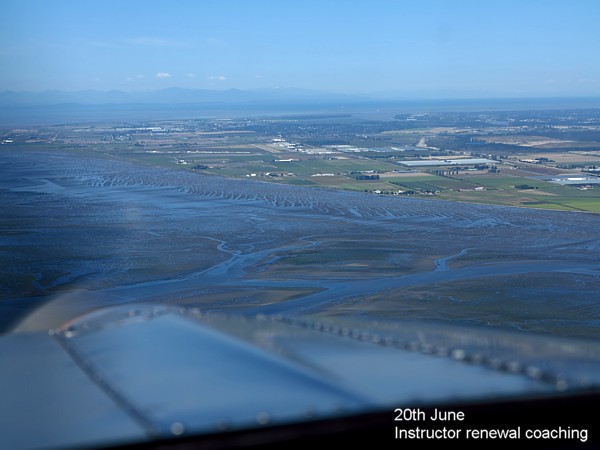
Back at Boundary Bay on the 20th June, and up with David in the Tomahawk doing the Climbing and Descending and Turning PPL lessons.
After flying with David I
was ready to catch Flair Airlines to Calgary from Vancouver..
Johnny from China wanted to look at a Maule that was for sale
near Okotoks.
When we were putting the Tomahawk in the hangar, Johnny turned up
and caught me before I drove to CYVR... The tickets had been
booked to fly from Abbotsford!
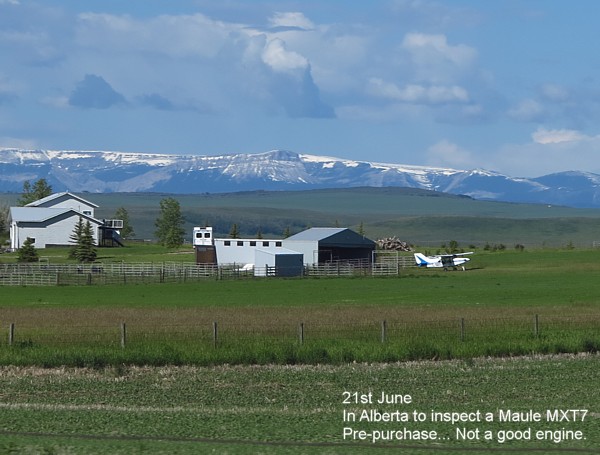
I have friends in aviation
everywhere it seems, and so Simon Youens very kindly picked us up
from Calgary and Johnny and I stayed overnight in Okotoks.
The Maule looked good, and honest until we took the cowlings off.
There was an oil leak from the joint between the crankcase halves
that had been bodge sealed with brown sealant. Evidence of poor
maintenance, and so a no-go. We flew Flair back to Abbotsford and
drove home.
The next day (22nd June), Johnny and I were flying the Citabria. He wants to do some bush flying in the future and so tailwheel is the way to go.
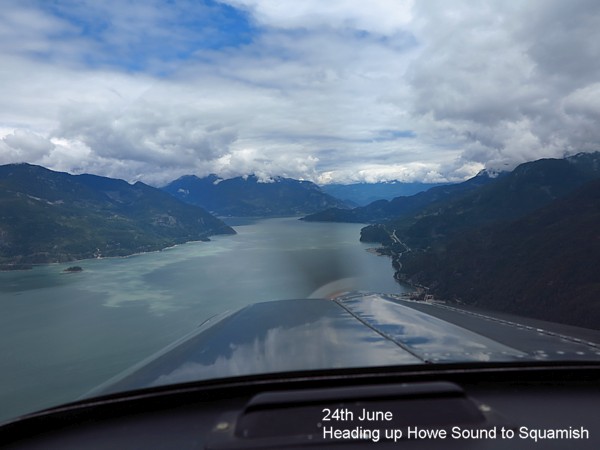
24th June, Alice and I flew
to Squamish in the Tomahawk where I flew again with Howard in the
Citabria, and then Alice had a go too.
The way back was high over the mountains to Widgeon Lake with
stalls in the Tomahawk on the way back down.
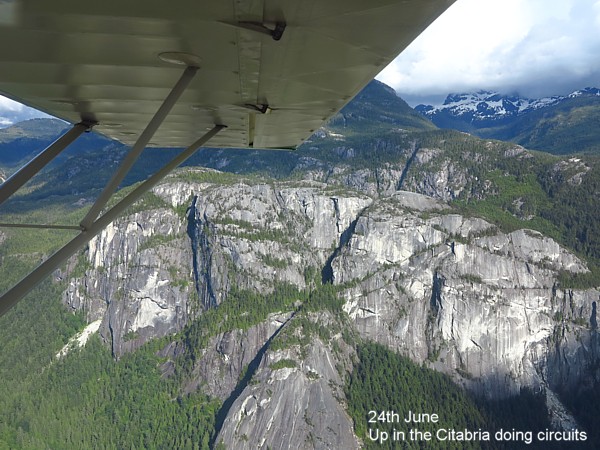
26th June, flying with Roel
again from Squamish... Alice lends me one of her BMW Minis to
drive around, and so I have had the enjoyable drive up and down
the Sea to Sky highway which is the only pleasant road journey
available in this part of the world.
The next day I turned 70, I can't believe it! But the weather was
grotty, wet and 15° Centigrade, and so the Standard Operating
Procedure of logging a birthday flight was not possible.
Made up for it the next day
by flying with Rory in his Cessna Cardinal to Chilliwack via
Chehalis Lake and Harrison Lake. Rory produced a video of this
flight.
We flew back to Boundary Bay low along the Fraser River then cut
across between the Pitt Meadows and Langley zones.
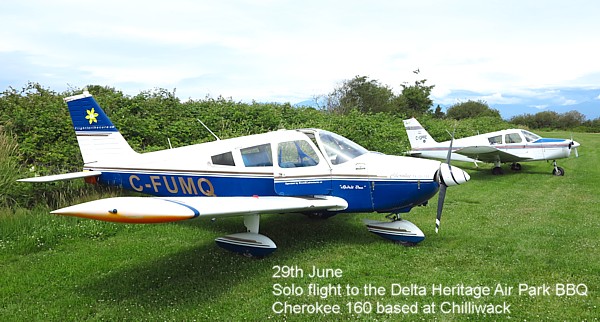
Nick wanted to see
his Cherokee 160 C FUMQ at the Delta HAP BBQ and so my brother
Gary flew me to Chilliwack in his Cherokee 140 to pick up the
"Q"'
I flew the Q from Chilliwack to Delta HAP and back, solo.
30th June I flew two lots of circuits with Johnny in the Citabria at Squamish.
July
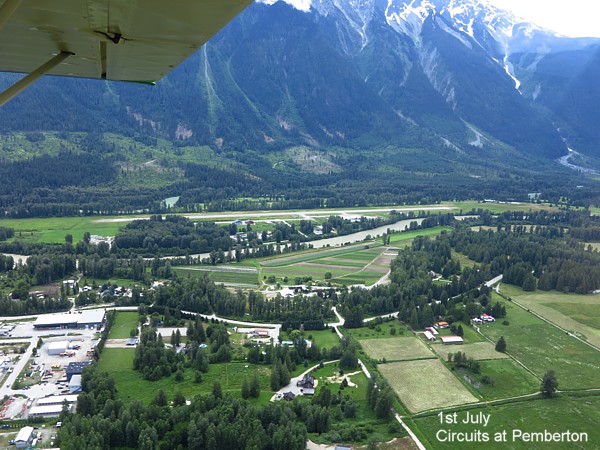
The next day I
flew two lots of circuits with Johnny, including a bit of
co-ordination exercises which are sometimes necessary when
learning to fly tailwheel.
I should not have been there, I was supposed to be on WestJet to
Calgary and London, but the mechanics went on strike and so my
flight was cancelled!
WestJet would have preferred me to take a refund which would have
meant me waiting up to six months for it and meanwhile having to
pay a large amount of money to another airline.
Always better to face a person, and so I went to Vancouver
airport and the WestJet agent there managed to book me on British
Airways BA084 on Wednesday 3rd.
BA were a little surprised when I turned up with my WestJet/BA
ticket, but managed to squeeze me on board. Thank you British
Airways.
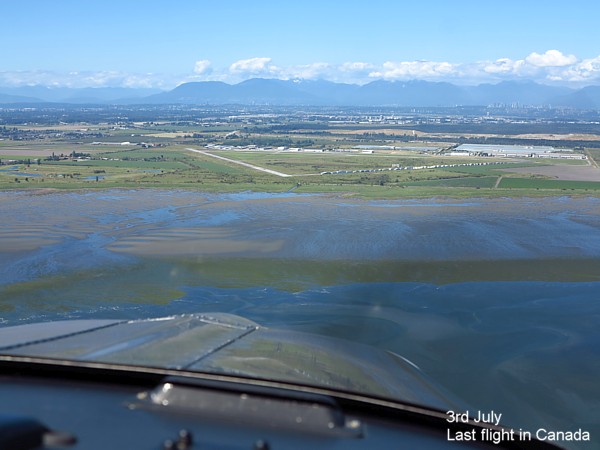
I managed one more flight
before my BA flight. This was with Pakorn who was a student of
mine a couple of times when he did his Canadian CPL in 2004/2005.
He is still an enthusiast and a very good pilot, but his flying
time is reserved by an airline where he is a Captain in the
Airbus 320.
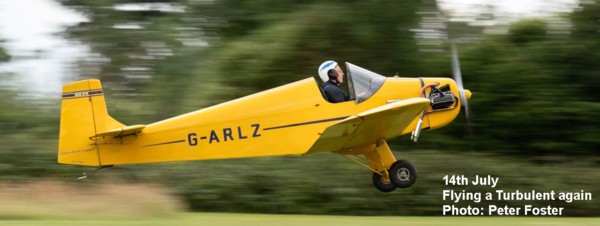
13th July I did two
familiarisation flights with prospective members of the proposed
Aircoupe group.
The Aircoupe has cost me a lot of money following years of poor
maintenance. New magnetos, new rudder cables, new trim cable, and
a rebuilt re-chromed nose leg. Money I can't afford on my very
limited pensions, and so I need partner(s) in the aeroplane. I
want to keep flying, and I freely admit to being stubborn! (So to
get rid of the aeroplane altogether and cut my losses though
'sensible' is not something I would entertain easily).
14th July Joy of joys, I
got to fly a Turbulent again, this time to take it from a very
tight sloping strip to Popham with it's expansive runways.
If I was to build an aeroplane it would have been a Turbulent.
Aerobility had built a Zenair 750 STOL and I was enlisted to do some of the test flying. On the 15th July the weather was deteriorating for the west, but allowed enough time for me to do three circuits in it at Blackbushe with David Groves, chief project engineer.
24th July two sets of circuits in the Aircoupe.
28th July I flew with group member Richard to Oaksey Park and back. Oaksey has a smooth grass runway.
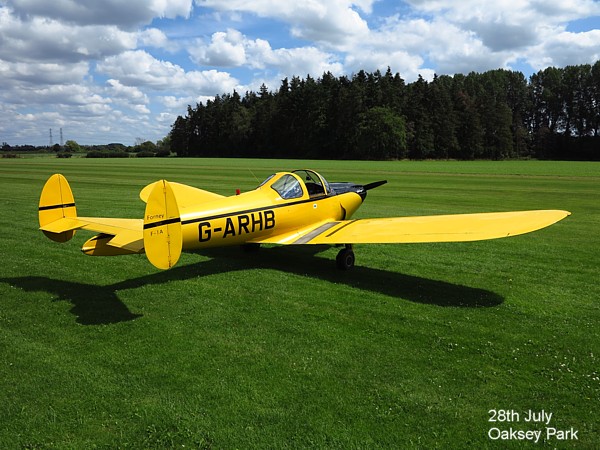
29th July, the Zenair 750
had to be picked up following the Farnborough Airshow and so I
was driven with a few others there.
I flew with Al Roser and we did 'trim runaway' testing on the way
back as well as a few other tests.
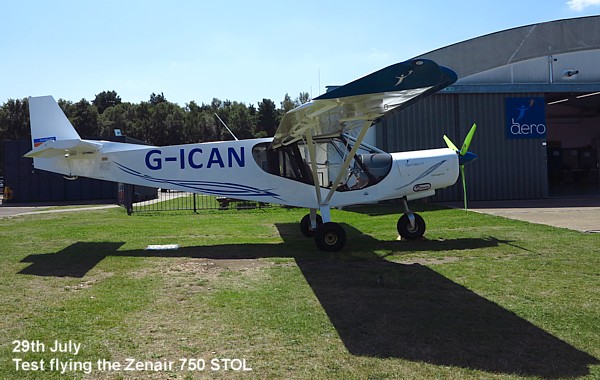
31st July, the Sling 2 had now received it's Permit to Fly and so it could go to Haverfordwest where Metal Seagulls was having a reception. I flew as passenger with Paul Kirkham. The aeroplane performed faultlessly.
August
On the 3rd of August there was a Fly-In at Eggesford and so I took Khun Ko for a flight there in the Aircoupe. Such an attractive aeroplane was given a prime parking position rather than being sent up the hill out of sight.
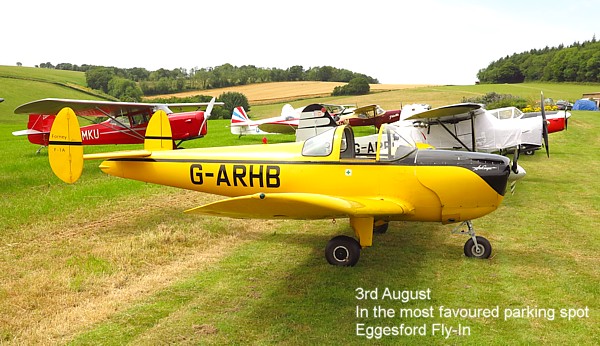
4th August, flying with Richard in the Aircoupe.
9th August, a third test flight with Mike Owen as observer in the Zenair 750 STOL from Blackbushe.
17th August, flew with Richard in the Aircoupe to Old Warden and back. It was the sixtieth anniversary of the Vintage Aircraft Club.
18th August, passenger
flight to the south coast and back to Popham with Paul in his
Sling 2.
26th August, Paul had fitted a grill to the top cowling and so we
tuft tested it in the Sling 2.
27th August, two flights with group members in the Aircoupe.
29th August, Craig took me for a ride to Welshpool in the SF260... We grounded up to 172 Knots on the way back; wind behind.
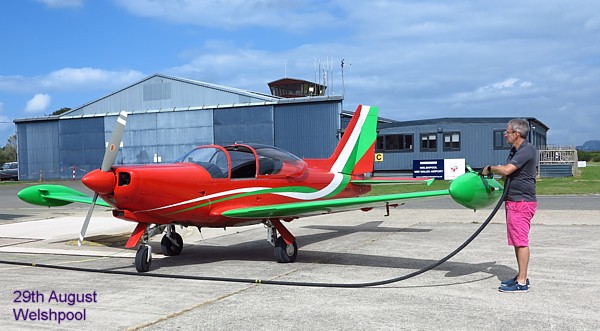
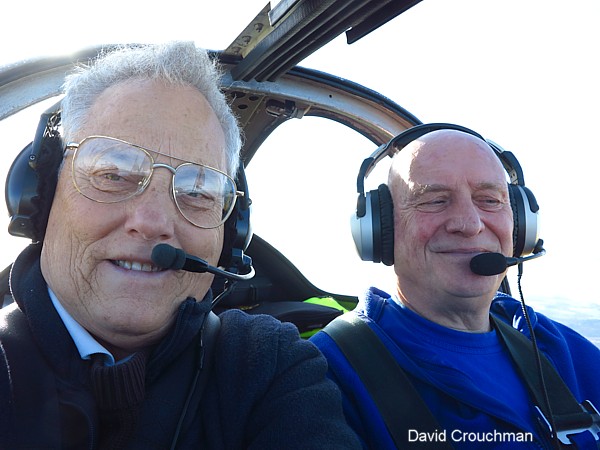
David has done the majority of check flight
hours this year.
September into December
13th September, flew with
Richard to Thruxton to do some circuits there, then back to
Popham after tea.
14th September, I took my niece from Vancouver, and my sister
from Brisbane, for flights in the Aircoupe.
15th September was
interesting. Best glide in the SF260 is at 82KIAS, but continue
this to the ground and you will hit hard! We discovered 90KIAS
worked well enough, allowing for roundout and a very short float.
Indeed this is the speed written on the American Emergency
Checklist.
The object was to do power off approaches and landings at
Thruxton which has a lot more room for such things.
After tea it was my turn to fly us back to Popham, and to
demonstrate landing on the scary runway 26... Here we go again, I
came in fast, 90KIAS, then down below 85 with a little power on
short final, and pulled off a decent landing this time. It was
intense!
After this, Craig kindly took another friend Trevor for a flight,
and then Trevor flew the Aircoupe with me.
17th September. I have a
somewhat wasted Class Rating Instructor Rating (CRI) here in
England. I do not have the reputation I built in the 1980's here
and so I rarely get any work. Today I had a flight to do in the
Auster AOP6 with Russell for his "one hour with an
instructor"..
I like to do something unusual on these recurrency flights and so
I taught him how to use the Reid & Sigrist blind flying
instrument. We also investigated various airspeeds by way of the
Canadian 'Range and Endurance' lesson. The objective I have is
more an expansion of skills rather than a simple test of current
skills.
28th September, a flight with Richard in the Aircoupe; navigation, steep turns, stalls, and a PFL.
5th October, flight with Richard in the Aircoupe. Afterward I went for a flight with Derek who was a member of the Condor Club in the 1980's, and then a partner in one of the Condors, G AWEI, and the Slingsby T67A G BIZN. He has been out of flying for too many years.
6th October, I had suggested fitting small blocks to the bottom of the Sling's rudder pedals to prevent unwarranted brake application. LAA had to approve this mod, and finally they did, provided a flight test was carried out by me. Of course I had to put Paul and his big feet in the left seat to properly test the mod. The mod worked perfectly in the Sling 2, and I would recommend it to any Sling/Sonaca owner. It's a common modification to rudder pedals.
11th October, a solo flight from Popham in the Aircoupe... 'Got to keep my hand in!
21st October, my turn to
get one hour with an instructor in, and so I flew with CRI David
Crouchman.
It doesn't matter who you are, in the second twelve months you
need at least twelve flying hours including one with an
instructor who signs your licence valid for another 24 months.
We went up and I managed 30 minutes under the hood, and we did
the Canadian Range and Endurance lesson which produced numbers
for the Aircoupe's performance chart. Since David instructs in
the Aircoupe, as a former CFI, I do my bit to improve his
instructional skills.
27th October, I took Khun
Ko up for a pleasure flight (picture below). Then Jeremy turned
up and he owed me a flight in his Bulldog.
In the Bulldog we did a couple of wingovers and a barrel followed
by two PFLs, and slow safe flight with rudder, trim and thottle
only all the way to short final when hands were allowed on the
stick to use the elevators to flare and land.
16th November, a flight with new group member Henry in the Aircoupe.
17th November, Iain Kirkham is creating an AI program to read aircraft instruments, this enroute to becoming a boffin. So we flew in the Aircoupe in which all the round instruments work in order to video record their movements as the aeroplane is manoeuvred.
I have not done as much flying as I am used to this year... There have been many demands on my time and limited funds.
I hope that I haven't bored
you too much.
The next update will be /2025.htm, have a brilliant New Year.
